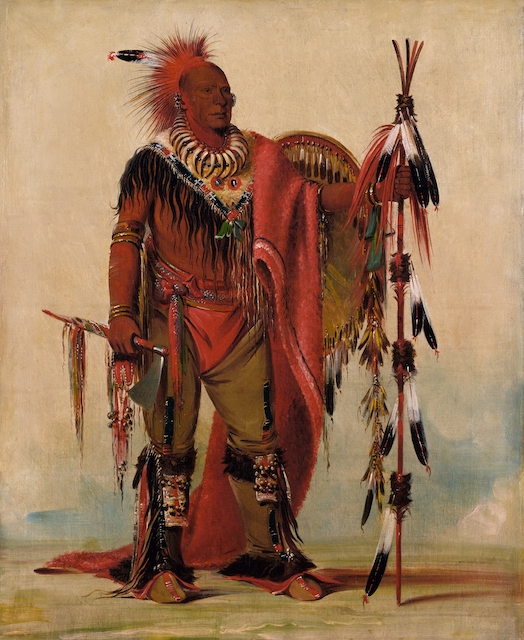
Artist George Catlin painted this oil on canvas — “Kee-o-kúk, The Watchful Fox, Chief of the Tribe” — at the Sac and Fox village in 1835. He described the chief as a “vain man” who was very pleased with his portraits, including this version. He wears an elaborate costume of white buckskin leggings, a red blanket, and a grisly bear-claw necklace over the skin of a white wolf on his neck while holding a shield on his arm and staff of office (sceptre) in one hand and a tomahawk in the other hand. Two years later, in 1837, Catlin brought Kee-o-kúk to Washington, D.C., where the artist showed his portraits, hoping the government would buy his Indian Gallery. During this visit, a journalist for the New York Evening Herald described the chief as a “fine and noble looking man.” Photo courtesy of Smithsonian American Art Museum
May/June 2022
(Volume 14, Issue 3)
By John Skipper
Sauk Chief Keokuk, for whom Iowa’s southernmost city is named, was a 19th century American Indian leader who historians have compared to King Solomon, to Daniel Webster and to a cunning riverboat gambler.
Indeed, a case can be made for all three comparisons of this man of peace in an age of war; whose oratory was often as effective a weapon as his sword; and who negotiated huge land deals in which, in exchange, his people got big monetary rewards and he made sure he got some for himself.
He was born about 1780 in Rock River in northwestern Illinois near what is now the city of Peoria. It was in Indian territory that stretched from Illinois into eastern Iowa.
At the age of 15, Keokuk fought off a Sioux intruder with his spear, all the while on horseback, gaining the respect of his elders who promoted him to the title of “brave,” an unusual distinction for someone his age. Also as a reward, he was allowed to be on horseback at Indian events, a distinction usually reserved for chiefs and other adult leaders.
As he grew older, his military prowess, but more importantly his wisdom and oratory skills led to his election as chief of Sauk tribes in the Illinois-Iowa territories.
His biographers fill many pages with accounts of his extraordinary decision-making and speaking skills when quick action was necessary.
There was the time when young Keokuk and his traveling party were at a campground in northern Iowa when they saw what appeared to be rival Sioux Indians approaching in what was intended as a surprise attack. Quickly, Keokuk ordered his men to dismount and arrange their horses in a tight, compact circle that served as a shield against the oncoming warriors. Thus, they fought their attackers off with few casualties.
When he was still a young man without power or authority, Keokuk stood outside a lodge in which an Indian Council meeting was being held. He overheard a discussion about rumors that U.S. soldiers were preparing to attack their villages. The council voted to have the area evacuated.
Hearing that, Keokuk entered the lodge and interrupted the meeting, a highly inappropriate action. He was granted permission to speak and urged the council to reconsider its decision to evacuate, solely on the basis of a rumor.
He reasoned that if the rumor turned out to be true, defending land that was rightfully theirs was more noble and honorable than fleeing. “Make me your leader,” he is reported to have said. “Let the young men follow me and the pale faces will be driven back to their towns.” The council rescinded its order. The invasion never occurred. The evacuation would have been unnecessary.
TO READ THE ENTIRE STORY AND OTHER FASCINATING STORIES ABOUT IOWA HISTORY, subscribe to Iowa History Journal.
